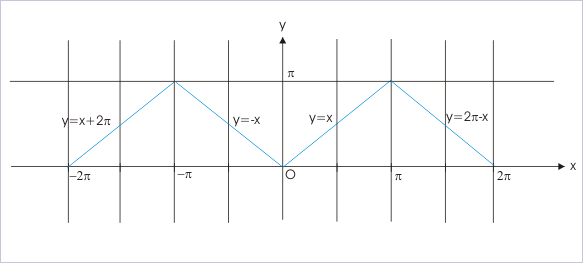| << Chapter < Page | Chapter >> Page > |
Hence,
In order to find expression corresponding to negative angle interval , we need to construct negative value diagram. We know that equivalent negative angle is obtained by deducting “-2π” to the positive angle. Thus, corresponding to expression for positive angles in four quadrants, the expression in terms of negative angles are “-θ”,“-π+θ”,“-π-θ” and “-2π+θ” in four quadrants counted in clockwise direction in the value diagram. Now, we estimate from the sine plot that an angle, corresponding to a positive acute angle, θ, in the principal interval, lies in third negative quadrant. Therefore,
Hence,
Combining three results,
|-π-x; x∈ [-3π/2, -π/2]
sin⁻¹ sinx = | x; x∈ [-π/2, π/2]| π- x; x∈ [π/2, 3π/2]
We can similarly find expressions for more such intervals.
Using three expressions obtained above, we can draw plot of the composition function. We extend the plot, using the fact that composition is a periodic function with a period of 2π. The equation of plot, which is equivalent to plot y=x shifted by 2π towards right, is :
The equation of plot, which is equivalent to plot y=x shifted by 2π towards left, is :
Sine inverse of sine

We see that graph of composition is continuous. Its domain is R. Its range is . The function is periodic with period 2π.
The composition evaluates to angle values lying in the interval [0, π].
Let us consider adjacent intervals such that all cosine values are included once. Such intervals are [π, 2π], [2π, 3π]etc on the right side and [-π, 0], [-2π, -π]etc on the left side of the principal interval.
Cosine function

The new interval represents third and fourth quadrants. The angle x, corresponding to positive acute angle θ, lies in fourth quadrant. Then,
Value diagrams

Hence,
In order to find expression corresponding to negative angle interval , we estimate from the cosine plot that an angle corresponding to a positive acute angle, θ, in the principal interval lies in first negative quadrant. Therefore,
Hence,
Combining three results,
|-x; x∈ [-π, 0]
cos⁻¹ cosx = | x; x∈[0, π]|2π- x; x∈ [π, 2π]
We can similarly find expressions for other intervals.
Using three expressions obtained above, we can draw plot of the composition function. We have extended the plot, using the fact that composition is a periodic function with a period of 2π. The equation of plot, which is equivalent to plot y=x shifted by 2π towards right, is :
The equation of plot, which is equivalent to plot y=x shifted by 2π towards left, is :
Cosine inverse of cosine

We see that graph of composition is continuous. Its domain is R. Its range is . The function is periodic with period 2π.

Notification Switch
Would you like to follow the 'Functions' conversation and receive update notifications?